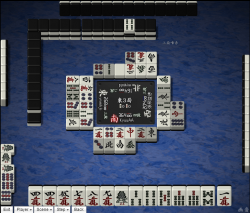Chinroutou: Difference between revisions
m (Grammar fix "any attempt require the" -> "any attempt requires the") |
(change wording at various points) |
||
| Line 12: | Line 12: | ||
* [http://tenhou.net/0/?log=2013020807gm-0009-7447-8494ff98&tw=3&ts=2 With] [[Suukantsu]] | * [http://tenhou.net/0/?log=2013020807gm-0009-7447-8494ff98&tw=3&ts=2 With] [[Suukantsu]] | ||
}} | }} | ||
'''Chinroutou''' {{kana|清老頭}} is a [[List of yaku#Yakuman|yakuman]] | '''Chinroutou''' {{kana|清老頭}} is a [[List of yaku#Yakuman|yakuman]] scored when every tile is a [[terminal]] (1 or 9). In other words, no [[tanyao|simples]] (2-8) or [[jihai|honors]] are allowed. For short, it can be referred to as '''chinro'''. | ||
==Tile pattern== | ==Tile pattern== | ||
| Line 18: | Line 18: | ||
==Routouhai== | ==Routouhai== | ||
'''Routouhai''' {{kana|老頭牌}} are the tiles numbered 1 or 9 | '''Routouhai''' {{kana|老頭牌}}, or "terminals" in English, are the tiles numbered 1 or 9. They are called "terminals" because they are always the end of a [[sequence]]; a tile group such as 9-1-2 is not a valid sequence. The terminals are as follows: | ||
:{{#mjt:19s19p19m}} | :{{#mjt:19s19p19m}} | ||
| Line 24: | Line 24: | ||
==Formation== | ==Formation== | ||
[[Image:Chinroutou denied.png|250px|thumb|right|Possible [http://tenhou.net/0/?log=2015090615gm-0089-0000-acd2836c&tw=3&ts=3 chinroutou threat] after two calls and a low terminal count among discards.]] | [[Image:Chinroutou denied.png|250px|thumb|right|Possible [http://tenhou.net/0/?log=2015090615gm-0089-0000-acd2836c&tw=3&ts=3 chinroutou threat] after two calls and a low terminal count among discards.]] | ||
For this yakuman, there are only six types of terminals available: two from each of the numbered suit (1 and 9). | For this yakuman, there are only six types of terminals available: two from each of the numbered suit (1 and 9). A standard winning hand is 4 melds and a pair, five out of the six types of terminals are needed to build the hand. | ||
Since there are only six tile types available for this hand, it is impossible to form a [[chiitoitsu]] variation. | |||
===Viability=== | ===Viability=== | ||
Aside from needing five out of the six terminal types, every tile group must be triplets | Aside from needing five out of the six terminal types, every tile group must be triplets (or [[kan]]s). So, any attempt at this yakuman requires the proper number of terminals as well as the ability to collect triplets. More often than not, players must make [[naki|tile calls]] in order to do so. Only a rare number of times can this yakuman be completed while closed. On the other hand, the yakuman is rendered impossible if enough terminals are discarded or made unavailable. | ||
==External links== | ==External links== | ||
Revision as of 05:51, 15 June 2024
| Type | Yakuman |
|---|---|
| Kanji | 清老頭 |
| English | All terminals |
| Value | Yakuman |
| Speed | Very slow |
| Difficulty | Very hard |
Chinroutou 「清老頭」 is a yakuman scored when every tile is a terminal (1 or 9). In other words, no simples (2-8) or honors are allowed. For short, it can be referred to as chinro.
Tile pattern
Routouhai
Routouhai 「老頭牌」, or "terminals" in English, are the tiles numbered 1 or 9. They are called "terminals" because they are always the end of a sequence; a tile group such as 9-1-2 is not a valid sequence. The terminals are as follows:
Formation

For this yakuman, there are only six types of terminals available: two from each of the numbered suit (1 and 9). A standard winning hand is 4 melds and a pair, five out of the six types of terminals are needed to build the hand.
Since there are only six tile types available for this hand, it is impossible to form a chiitoitsu variation.
Viability
Aside from needing five out of the six terminal types, every tile group must be triplets (or kans). So, any attempt at this yakuman requires the proper number of terminals as well as the ability to collect triplets. More often than not, players must make tile calls in order to do so. Only a rare number of times can this yakuman be completed while closed. On the other hand, the yakuman is rendered impossible if enough terminals are discarded or made unavailable.
External links
- Chinroutou in Japanese Wikipedia
- 【麻雀】望月雅継の清老頭!! (YouTube)
- Tournament Chinroutou
| |||||||||||||||||||||||||||||||
